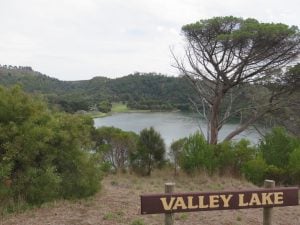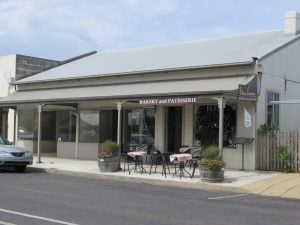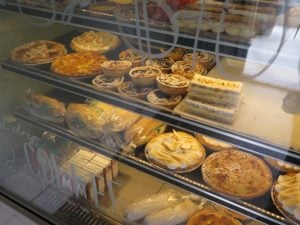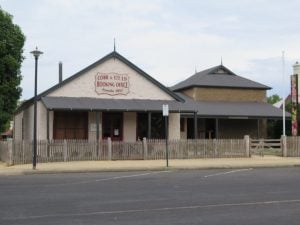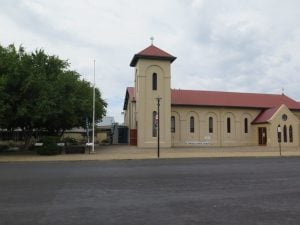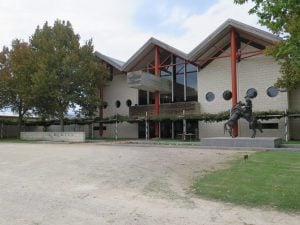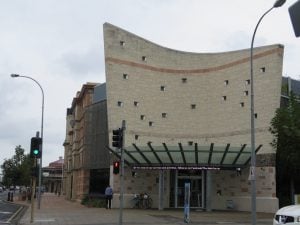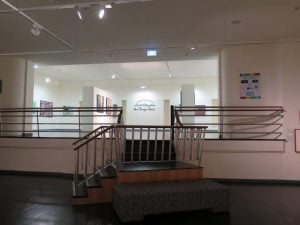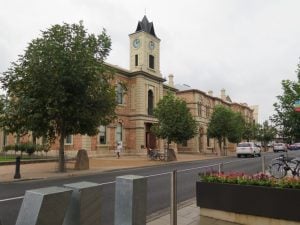The fascinating Blue Lake from Apex Reserve, Mount Gambier
23 March 2016
This morning we caught up with some washing before setting off for the day. We were looking forward to seeing the Blue Lake, so this was our first stop. At the cafe we had a coffee and a toastie, before walking up to the Apex Lookout.
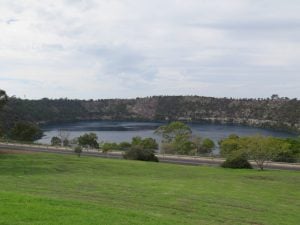 As one of the most-visited tourist spots in Mount Gambier, the Blue Lake is considered to be the gem of Mount Gambier’s tourist attractions. It is certainly a unique and breathtaking sight which awes thousands of visitors year after year. Nestled on a gorgeous volcanic landscape, the Blue Lake inhabits one of the extinct volcanic craters of Mount Gambier. The Lake provides the water supply to Mount Gambier. (Photo right taken from near Valley Lake)
As one of the most-visited tourist spots in Mount Gambier, the Blue Lake is considered to be the gem of Mount Gambier’s tourist attractions. It is certainly a unique and breathtaking sight which awes thousands of visitors year after year. Nestled on a gorgeous volcanic landscape, the Blue Lake inhabits one of the extinct volcanic craters of Mount Gambier. The Lake provides the water supply to Mount Gambier. (Photo right taken from near Valley Lake)
The Blue Lake is almost in the middle of the city of Mount Gambier and a road circles the Blue Lake. It looked very beautiful and very blue! It was a little cloudy and it remained that way for most of the day, however if it is a clearer morning tomorrow we will revisit to see if we can find a more blue Blue Lake! To the naked eye it looked a deep cobalt blue, but not sure how it will photograph.
A little further out of town there is a road leading to a lookout for the Valley Lake, and a view of the Blue Lake from the opposite side to where we initially stopped. The geology around Mount Gambier is very interesting, and one could spend many hours visiting the different sites, however you can read more about the geology here
The host at our motel had pointed out to us that we were not far from the Coonawarra wine country, so we decided to visit. Penola was the first town we visited, and we spent about an hour there looking at and photographing the many heritage buildings. A surprise find was a French Patisserie – so we had to have a coffee and a (huge) vanilla slice (for Pete) and a berry and almond cream tart for me. Unfortunately the cafe is to close tomorrow because of the owner’s health – and I’m sure the locals will miss the goodies!
Penola is a fascinating, historic and picturesque country town that is the service centre to the Coonawarra wine region. The town was founded in 1850 by Scottish born Alexander Cameron paving the way for future generations and known by his contemporaries as the “King of Penola”, with Founders day celebrated annually on April 4th. Another prominent figure in Penola’s history was Scottish born John Riddoch who had a profound impact on the district. He established the Penola Fruit Growing Colony in 1890, renamed Coonawarra in 1897, built “Yallum Park” a two storey mansion in 1880 and opened or laid foundation stones for many early buildings in the district.
Mary MacKillop, now known as Saint Mary of the Cross Mackillop, is Australia’s first Saint. Together with Father Julian Tennison Woods founded the religious order, the Sisters of St Joseph, in Penola 134 years ago. In 1867 the Woods MacKillop Schoolhouse was established for the children of the of the district. The Mary MacKillop Interpretive Centre was opened in 1998.
Poets, Adam Lindsay Gordon, William Ogilvie and Penola born John Shaw Neilson left behind a legacy of poetry inspired by their experiences of rural life in the district. A stroll around Penola reveals the many National Trust buildings and privately owned residences that provide a postcard reminder of a by-gone era.
We drove along Petticoat Lane to admire the delightful cottages and gardens, saw the Cobb & Co Booking Office and the Mary MacKillop Interpretive Centre.
After a very pleasant drive past numerous pine forests, we came to the Coonawarra region with wineries and cellar doors along the main road for several kilometres. It had been recommended that we visit Wynn’s Winery and Rymill winery (left), which we did, and learned why the mainly red wine area produces their highly successful products.
Long and narrow, this celebrated ridge of earth, together with pure underground water, cool nights and a long, mild growing season, is Nature’s gift to wine lovers across the globe. This precious parcel of land is some of the most valuable agricultural land in the nation, and recognised as Australia’s premier red wine region, contributing fruit to some of the finest wines in the world. You can read more about the Coonawarra region here
The impressive entrance to Rymill Winery
 All too soon it was time to head back to Mount Gambier because we wanted to explore the city centre, and especially the Riddoch Art Gallery, the Cave Garden, the historic buildings and the Umpherston Sinkhole. Parking was easy in the main centre, and we first made our way to the Cave Garden in the centre of town. The Cave Garden precinct features a sinkhole that was the original water source for the town. Famous for its beautiful rose garden and stunning waterfall in the winter rain, it is also a great place for a relaxing picnic. Suspended viewing platforms offer awesome views into the cave.
All too soon it was time to head back to Mount Gambier because we wanted to explore the city centre, and especially the Riddoch Art Gallery, the Cave Garden, the historic buildings and the Umpherston Sinkhole. Parking was easy in the main centre, and we first made our way to the Cave Garden in the centre of town. The Cave Garden precinct features a sinkhole that was the original water source for the town. Famous for its beautiful rose garden and stunning waterfall in the winter rain, it is also a great place for a relaxing picnic. Suspended viewing platforms offer awesome views into the cave.
The Main Corner of Mount Gambier is a Cultural and Community complex showcasing the beauty of Mount Gambier’s natural and cultural history (below left). The complex also includes the Riddoch Art Gallery which is the largest and finest regional gallery in South Australia. It was first opened in the Mount Gambier Institute in 1887 and in 2011 redevelopment of the gallery was undertaken as part of the Main Corner Project. A section of the gallery was once a theatre, and the original stage remains as part of the exhibitions (right).
Some of the spectacular historic buildings in the city centre
Our last visit for the day was the unusual Umpherston Sinkhole. As we had forgotten all about lunch we stopped at the cafe for a coffee and muffin, then continued to the Sinkhole as it started to rain lightly. James Umpherston in 1884 created a Victorian garden in the big hole on his sprawling estate. He planted ferns, shrubs and trees, and launched a dinghy on the small lake that once covered a third of the sinkhole’s floor. After his death in 1900 the garden fell into disrepair, until 1976 when the Woods and Forest Department, who then owned the land, set about restoring it. And what a fantastic job they did. The lake has since dried up, but in its place are lawned terraces covered in ferns, assorted leafy shrubs and hundreds of hydrangeas that burst into colour each summer. Two towering palms reach for the sky and the walls of the sinkhole are draped in curtains of ivy. A stairway leads to the floor and underneath a rock ledge there are a couple of barbecues and tables. We didn’t walk to the bottom of the sinkhole as the rain was getting a bit heavier, but it is certainly a most unusual and strangely beautiful place to visit.
Tonight we will again have some cheese, dip, crackers etc for dinner at our motel after a fairly tiring day. Tomorrow will again be a long day as we travel from Mount Gambier heading toward the coast and through Millicent, Beachport, Robe, Kingston, along the Coorong and north to Murray Bridge – getting closer to our three day cruise on the paddle steamer on the Murray River!


